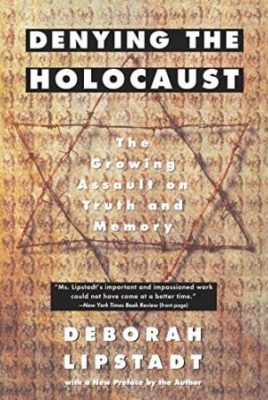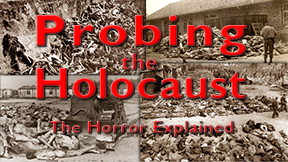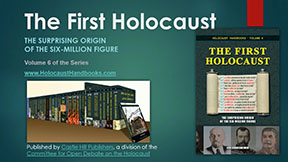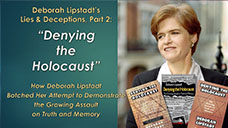In 1993 Deborah Esther Lipstadt, a U.S.-American professor of Jewish history and Holocaust research, published a book entitled Denying the Holocaust: The Growing Assault on Truth and Memory, in which she gives her perspective of the political background, motivations and “spurious methodology” (p. 111) of the revisionists, and also tries to deal with some revisionist arguments (see the cover illustration to the right).[1]
As I write these lines, the book is 23 years old. Normally, that would be a good reason to ignore it as outdated. But assuming this would be a grave mistake. Although the sales ranking on Amazon does not indicate that it is a bestseller by any stretch of the imagination (in late August 2016 it was roughly no. 500 in the category “Holocaust”), the book is as relevant today as it was when it had just appeared.
The reason for the book’s importance is not so much its contents but rather its political and historical impact. One of the persons whose political background, motivations and methods Lipstadt briefly mentions in the book is the British historian David Irving. Lipstadt depicts him in her book as a racist, anti-Semitic Holocaust denier. David Irving, who was once considered the most successful historian of contemporary history in the world due to having the most editions of his works in circulation, didn’t like his reputation smeared by Dr. Lipstadt, so he decided to sue her for defamation.
The libel suit unfolding in London in 1999/2000, however, ended in a complete disaster for Irving, since, in the verdict of the ruling judge, the defendants – Lipstadt and her publisher – managed to prove most of the claims made against Irving as true.[2]
As a consequence, a number of books appeared documenting not only Irving‘s complete and utter defeat but also claiming that, as a corollary, “Holocaust denial” has finally been exposed as a pseudo-historical movement driven by ulterior political motives and with no basis in factual reality.[3]
Lipstadt’s case became so famous – or was considered so important to and by the mainstream – that her own account of the trial as published in her book History on Trial: My Day in Court with David Irving (Ecco, New York 2005) has been turned into a movie which is to be released in September 2016; parallel to this, her book telling her story of the trial will be reissued under the same title as the movie: Denial: Holocaust History on Trial. Irving, for his part, has continued his previous preoccupation with matters of history (see his website at www.fpp.co.uk).
Lipstadt’s original work which triggered all this is also about to be reissued, emphasizing the fact that the mainstream still considers this 23-year-old book to be highly relevant and topical. This new edition slated for December 2016 is described by the publisher as follows:[4]
“The denial of the Holocaust has no more credibility than the assertion that the Earth is flat. Yet there are those who insist that the death of six million Jews in National Socialist concentration camps is nothing but a hoax perpetrated by a powerful Zionist conspiracy. For years those who made such claims were dismissed as harmless cranks operating on the lunatic fringe. But they have now begun to gain a hearing in respectable arenas. In this famous book, reissued now to coincide with the film based on the legal case it provoked, Denial, Deborah Lipstadt shows how—despite tens of thousands of witnesses and vast amounts of documentary evidence—this irrational idea not only has continued to gain adherents but has become an international movement, with ‘independent’ research centres, and official publications that promote a ‘revisionist’ view of recent history. Denying the Holocaust argues that this chilling attack on the factual record not only threatens Jews but has an unsuspected power to dramatically alter the way that truth and meaning are transmitted from one generation to another.”
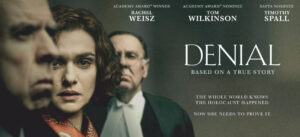
Promotion poster for the upcoming movie Denial about David Irving‘s defamation suit against Deborah Lipstadt.
The present book will neither deal with Irving‘s libel suit against Lipstadt nor with any of the publications based on it. It will exclusively deal with Lipstadt’s 1993 book Denying the Holocaust. Once the new edition has been released, I will also evaluate in a new edition of the present study whether, and if so then to what degree, the new edition has been amended, corrected and/or updated (unless it is a mere reprint, in which case this present edition will remain in print).

Deborah E. Lipstadt
Parallel to the present extended review, another book-size review is being prepared by a different author who analyzes Lipstadt’s account of the trial, that is to say, her book History on Trial, as well as the movie Denial based on this book. It will be released as yet another volume of our Fail series.This extended review will analyze Lipstadt’s methods as well as her arguments in order to evaluate whether and to what degree her numerous claims about Holocaust revisionism aka denial – its motives and methods – are true. In doing so, I will not analyze all of her claims, as this would inflate the present study to a volume far exceeding Lipstadt’s own book, but will focus on a number of representative examples.
Before immersing myself in the matter, I may point out that a thorough and exhaustive evaluation of the evidence presented during Irving‘s defamation suit by expert witness for the defense Dr. Robert van Pelt, professor for cultural history, was published in the English language already in 2010.[5] I will on occasion refer to this work, among others, for further reading.
It goes without saying that any new edition of Lipstadt’s initial book, if giving the impression that it is more than just a historic reprint of the original, would have to be updated by considering the development of “Holocaust denial” since 1993, and also by taking into consideration any corrections necessary due to 23 years of ensuing historical research.
In fact, between the appearance of the first edition of Denying the Holocaust in 1993 and the recently announced new edition of 2016, many new, ground-breaking revisionist studies have appeared as journal articles and books, which no serious scholar claiming to refute the “deniers” can ignore. To be easy on Dr. Lipstadt, I ignore here the many relevant works published in other languages, foremost those in Italian, German and French, and will focus exclusively on those in the English language. And to be even more merciful to her, I name here no journal articles but only monographs, and among them only the most important ones (most of which are part of the revisionist series Holocaust Handbooks. I omit the already-mentioned work critiquing van Pelt’s book on Auschwitz as cited in footnote 5):
– Joseph Halow, Innocent at Dachau, Institute for Historical Review, Newport Beach 1993
– Germar Rudolf (ed.), Dissecting the Holocaust: The Growing Critique of ‘Truth’ and ‘Memory’, Theses & Dissertations Press, Capshaw, AL, 2000 (2nd ed., ibid., 2003)
– Jürgen Graf, The Giant with Feet of Clay: Raul Hilberg and his Standard Work on the ‘Holocaust’, Theses & Dissertations Press, Capshaw, AL, 2001 (2nd ed., Castle Hill Publishers, Uckfield, 2015)
– Germar Rudolf, The Rudolf Report: Expert Report on Chemical and Technical Aspects of the “Gas Chambers” of Auschwitz, Theses & Dissertations Press, Chicago 2003 (2nd ed., The Barnes Review, Washington, D.C., 2011)
– Jürgen Graf, Carlo Mattogno, Concentration Camp Stutthof: Its History & Function in National Socialist Jewish Policy; Theses & Dissertations Press, Chicago 2003 (4th ed., Castle Hill Publishers, Uckfield 2016)
– Jürgen Graf, Carlo Mattogno, Concentration Camp Majdanek: A Historical and Technical Study; Theses & Dissertations Press, Chicago 2003 (3rd ed., The Barnes Review, Washington, D.C., 2012)
– Don Heddesheimer, The First Holocaust: The Surprising Origin of the Six-Million Figure; Theses & Dissertations Press, Chicago 2003 (3rd ed., Castle Hill Publishers, Uckfield 2015)
– Carlo Mattogno, Jürgen Graf, Treblinka: Extermination Camp or Transit Camp?, Theses & Dissertations Press, Chicago 2004
– Carlo Mattogno, Belzec in Propaganda, Testimonies, Archeological Research, and History, Theses & Dissertations Press, Chicago 2004
– Carlo Mattogno, Special Treatment in Auschwitz: Origin and Meaning of a Term, Theses & Dissertations Press, Chicago 2004 (2nd ed., Castle Hill Publishers, Uckfield 2016)
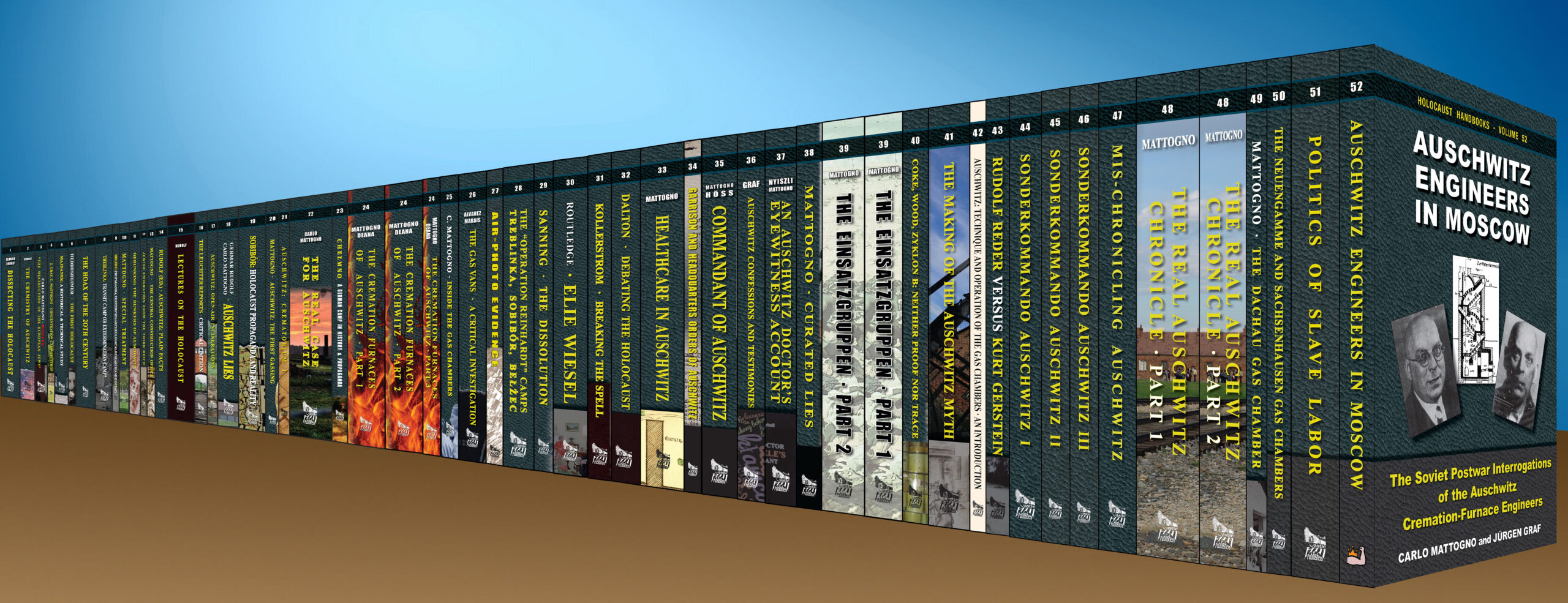
All 52 scientific studies that comprise the prestigious, revisionist series Holocaust Handbooks published or in preparation as of February 2024. For more information, see the descriptions on the linked website.
– Carlo Mattogno, The Bunkers of Auschwitz: Black Propaganda versus History, Theses & Dissertations Press, Chicago 2004 (2nd ed., Debunking the Bunkers of Auschwitz, Castle Hill Publishers, Uckfield 2016)
– Carlo Mattogno, The Central Construction Office of the Waffen-SS and Police Auschwitz: Organization, Responsibilities, Activities, Theses & Dissertations Press, Chicago 2005 (2nd ed., Castle Hill Publishers, Uckfield 2015)
– Germar Rudolf (ed.): Auschwitz: Plain Facts: A Response to Jean-Claude Pressac, Theses & Dissertations Press, Chicago 2005 (2nd ed., Castle Hill Publishers, Uckfield 2016)
– Germar Rudolf, Lectures on the Holocaust: Controversial Issues Cross Examined, Theses & Dissertations Press, Chicago 2005 (2nd ed., The Barnes Review, Washington, D.C., 2010)
– Fred A. Leuchter, Robert Faurisson, Germar Rudolf, The Leuchter Reports: Critical Edition, Theses & Dissertations Press, Chicago 2005 (4th ed., Castle Hill Publishers, Uckfield 2015)
– Carlo Mattogno, Auschwitz: Open Air Incinerations, Theses & Dissertations Press, Chicago 2005
– Germar Rudolf, Carlo Mattogno, Auschwitz Lies: Legends, Lies, and Prejudices on the Holocaust, Theses & Dissertations Press, Chicago 2005 (3rd ed., Castle Hill Publishers, Uckfield 2016)
– Carlo Mattogno, Auschwitz: The First Gassing: Rumor and Reality, Theses & Dissertations Press, Chicago 2005 (3rd ed., Castle Hill Publishers, Uckfield 2016)
– Carlo Mattogno, Auschwitz: Crematorium I and the Alleged Homicidal Gassings, Theses & Dissertations Press, Chicago 2005
– Thomas Dalton, Debating the Holocaust: A New Look at Both Sides, Theses & Dissertations Press, New York 2009 (2nd ed., Castle Hill Publishers, Uckfield 2015)
– Samuel Crowell, The Gas Chamber of Sherlock Holmes, Nine-Banded Books, Charleston, WV, 2010
– Jürgen Graf, Thomas Kues, Carlo Mattogno, Sobibór: Holocaust Propaganda and Reality, The Barnes Review, Washington, D.C., 2010
– Carlo Mattogno, Chelmno: A German Camp in History and Propaganda, The Barnes Review, Washington, D.C., 2011
– Santiago Alvarez, The Gas Vans: A Critical Investigation, The Barnes Review, Washington, D.C., 2011
– Carlo Mattogno, Jürgen Graf, Thomas Kues, The “Extermination Camps” of “Aktion Reinhardt”: An Analysis and Refutation of Factitious “Evidence,” Deceptions and Flawed Argumentation of the “Holocaust Controversies” Bloggers, Castle Hill Publishers, Uckfield 2013 (2nd ed., ibid., 2015)
– Carlo Mattogno, Inside the Gas Chambers: The Extermination of Mainstream Holocaust Historiography, The Barnes Review, Washington, D.C., 2014
– Nicholas Kollerstrom, Breaking the Spell: The Holocaust, Myth & Reality, Castle Hill Publishers, Uckfield 2014 (2nd ed., ibid., 2015)
– Warren B. Routledge, Holocaust High Priest: Elie Wiesel, “Night,” the Memory Cult, and the Rise of Revisionism, Castle Hill Publishers, Uckfield 2015
– Carlo Mattogno, Franco Deana, The Cremation Furnaces of Auschwitz: A Technical and Historical Study, Castle Hill Publishers, Uckfield 2015
– Carlo Mattogno, Curated Lies: The Auschwitz Museum’s Misrepresentations, Distortions and Deceptions, Castle Hill Publishers, Uckfield 2016
– Carlo Mattogno, Healthcare in Auschwitz: Medical Care and Special Treatment of Registered Inmates, Castle Hill Publishers, Uckfield 2016
In addition to these, there are also a few important revisionist monographs that appeared in the English language prior to 1993, although Lipstadt does not mention them at all:
– Walter N. Sanning, The Dissolution of Eastern European Jewry, Institute for Historical Review, Torrance, CA, 1983 (2nd ed., Castle Hill Publishers, Uckfield 2015)
– Wilhelm Stäglich, The Auschwitz Myth: A Judge Looks at the Evidence, Institute for Historical Review, Torrance, CA, 1986 (3rd ed., Auschwitz: A Judge Looks at the Evidence, Castle Hill Publishers, Uckfield 2015)
– John C. Ball, Air Photo Evidence, self-published, Delta, B.C., 1992 (3rd ed., Castle Hill Publishers, Uckfield 2015)
The first book listed is about Jewish population statistics, a topic addressed by Lipstadt in her book. I will come back to it when addressing Lipstadt’s arguments in this regard. The second book would be of interest only when tracking the history of revisionism, as most of its contents has been superseded by more recent research results. Ball’s book on air-photo evidence would be very important when discussing documentary evidence for the Holocaust and the way revisionists interpret it, but since Lipstadt has clearly stated that she enters only very reluctantly into any discussions of facts involved in the matter at hand, she has stayed away from this issue. Whether such an approach is justified or even justifiable will be one of the many issues that I will discuss in the present book.
Germar Rudolf, Red Lion, August 28, 2016
[1] Deborah E. Lipstadt, Denying the Holocaust, Free Press, New York 1993 (paperback: Plume/Penguin Books, New York/London 1994). If not indicated otherwise, page numbers refer to the 1994 paperback edition.
[2] That libel case has been thoroughly documented online: www.hdot.org
[3] For a documentation of the trial see Don D. Guttenplan, The Holocaust on Trial: History, Justice and the David Irving Libel Case, Granta Books, London/ W. W. Norton & Company, New York 2001; for a hostile evaluation of Irving as a historian see Richard J. Evans, Lying About Hitler: History, Holocaust, and the David Irving Trial, Basic Books, New York 2001; for the evidence on exterminations at Auschwitz presented by the defense see Robert J. van Pelt, The Case for Auschwitz: Evidence from the Irving Trial, Indiana University Press, 2002.
[4] www.amazon.com/dp/0141985518; retrieved on Aug. 27, 2016.
[5] Carlo Mattogno, Auschwitz: The Case for Sanity: A Historical and Technical Study of Jean-Claude Pressac’s “Criminal Traces” and Robert Jan van Pelt’s “Convergence of Evidence”, The Barnes Review, Washington, D.C., 2010; 2nd ed.: The Real Case for Auschwitz: Robert van Pelt’s Evidence from the Irving Trial Critically Reviewed, Castle Hill Publishers, Uckfield, 2015; holocausthandbooks.com/dl/22-trcfa.pdf (Aug. 27, 2016).

